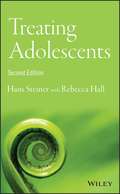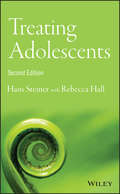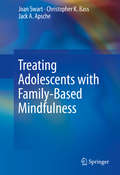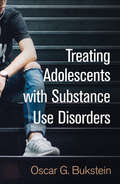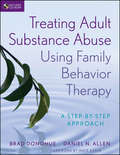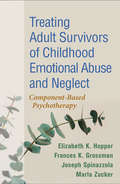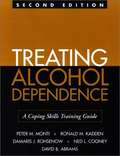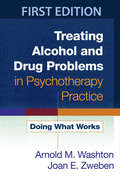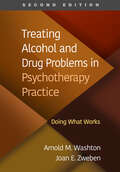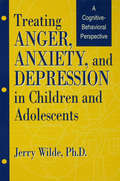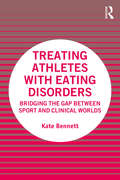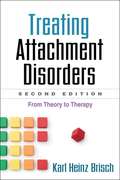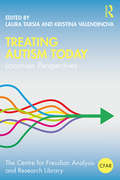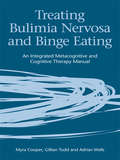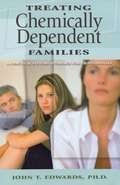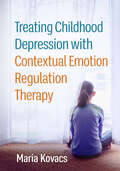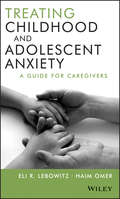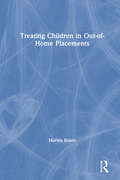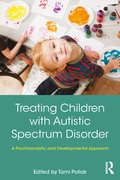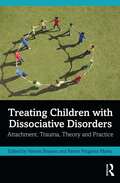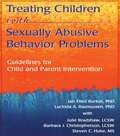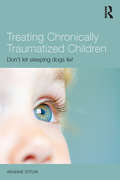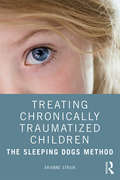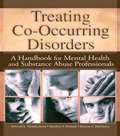- Table View
- List View
Treating Adolescents
by Rebecca Hall Hans SteinerUnderstand disruptive behaviors and ADHD more deeply, Treat anxiety, depression, and mood disorders more effectively, Handle psychiatric traumas and related psychopathologies, Delve into substance abuse, self-harm, eating disorders, and more.
Treating Adolescents (Library Of Current Clinical Technique)
by Hans Steiner Rebecca E. HallA unique guide to adolescent psychopathology, using a developmental approach Treating Adolescents is a comprehensive guide to adolescent mental health care, synthesizing evidence-based practice and practice-based perspectives to give providers the best advice available. By limiting the discussion to disorders which appear during adolescence, this useful manual can delve more deeply into each to present extensive evidence and practice-based rationales for approaching a range of psychopathologies. This edition has been revised to reflect the changes in the DSM-5 and the ICD-10, with entirely new chapters on ADHD, learning and executive function, bipolar and mood disorders, sleep disorders, and suicide and self-injury. Coverage includes non-therapy interventions, such as pharmacological and environmental. The discussion of schizophrenia and psychotic disorders includes adolescent presentations of Pervasive Developmental Disorders and their relationship to classical schizophrenia. In a developmental approach to adolescent psychopathology, different treatments are carefully integrated and matched to pathogenic processes in an effort to disrupt causal loops. This book provides in-depth guidance for providers seeking well-rounded treatment plans, with detailed explanations and expert insight. Understand disruptive behaviors and ADHD more deeply Treat anxiety, depression, and mood disorders more effectively Handle psychiatric traumas and related psychopathologies Delve into substance abuse, self-harm, eating disorders, and more Current scholarship favors developmental approaches to psychopathology and supports an emphasis on integrated treatment packages, including environmental, biologic, and psychological interventions. With full integration of practice and research, Treating Adolescents is a comprehensive reference for constructing a complete treatment strategy.
Treating Adolescents with Family-Based Mindfulness
by Joan Swart Christopher K. Bass Jack A. ApscheA new take on therapeutic mindfulness with specific applications to troubled and delinquent youth is the focus of this innovative text. It introduces Family Mode Deactivation Therapy (FMDT) and its core concepts and methodologies, differentiating it from other cognitive and mindfulness therapies for adolescents with problem behaviors and comorbid conditions. Step by step applications of FMDT from case conceptualization to assessment and treatment are featured, with detailed case studies demonstrating its effectiveness in treating mood disorders, aggressive behavior and trauma and guidelines for its use with abusive families and other complex cases. The book's depth of clinical detail and appendix of therapist tools make it especially practical. Included in the coverage: A comparison of MDT with other cognitive approaches. The empirical status of MDT. Mindfulness in MDT process, and in the treatment room. FMDT and sexual offender youth. MDT and mindfulness in the context of trauma. Treating the "untreatable": FMDT and challenging populations. While Treating Adolescents with Family-Based Mindfulness is immediately useful to practicing psychotherapists, it should also be of interest to other professionals with a role in adolescent health care, such as policymakers, social workers, supervisors, juvenile corrections and youth center personnel and students and researchers.
Treating Adolescents with Substance Use Disorders
by Oscar G. BuksteinFrom a leading addiction specialist, this highly practical book explores what works in treating adolescents. Oscar G. Bukstein answers the clinician's vital question: "What do I do now?" He describes best practices for enhancing youths' motivation for change, teaching a variety of recovery skills, and implementing parent management training and parent–adolescent problem solving. The book covers ways to foster a prosocial peer network and to address mental health problems that co-occur with substance use disorders (SUDs). Clinicians can combine the strategies into an integrated approach or pick and choose depending on the needs of individual clients. Reproducible handouts and worksheets can be downloaded and printed in a convenient 8 1/2" x 11" size.
Treating Adult Substance Abuse Using Family Behavior Therapy
by Nathan H. Azrin Brad Donohue Daniel N. AllenPraise for Treating Adult Substance Abuse Using Family Behavior Therapy"Treating Adult Substance Abuse Using Family Behavior Therapy is a welcome addition to the evidence-based substance use disorder treatment literature. This volume provides a large amount of helpful information, materials, and step-by-step instructions for implementing and troubleshooting family-based behavioral treatment for substance use problems."--Mark B. Sobell, PhD, ABPP, Professor, and Linda Sobell, PhD, ABPP, Professor and Associate Director of Clinical Training, Center for Psychological Studies, Nova Southeastern University, Fort Lauderdale-Davie, FL"I strongly recommend Treating Adult Substance Abuse Using Family Behavior Therapy. Donohue and Allen give readers a step-by-step approach using empirical strategies, client-therapist dialogues, checklists, and handouts that make the therapy process clear and concrete. This book is a must-read for all who want to use FBT in their practice."--Robert J. Meyers, PhD, Emeritus Associate Research Professor of Psychology, University of New Mexico"I am delighted with the book Treating Adult Substance Abuse Using Family Behavior Therapy. As a relatively new therapist, I used the FBT protocols in a practice setting and the highly structured interventions provided me a sense of confidence while developing professional competence in working with very challenging populations. Although simple in theory, families are empowered by these absolutely positive techniques."--Amy S. Bizjak, Staff Development Training Coordinator, Bethesda Children's Home, Meadville, PAPractical, step-by-step guidance for using Family Behavior Therapy (FBT) in the treatment of adults dealing with substance abuseTreating Adult Substance Abuse Using Family Behavior Therapy clearly explains how this evidence-supported treatment can be implemented in a flexible, straightforward manner and covers:The underlying framework and infrastructure necessary for treatment providers to effectively implement FBTStrategies for establishing effective consumer-driven treatment plans with clients prior to each sessionSkills training and exercises that teach conflict management and how to build healthy relationshipsStandardized methods for managing problems that coexist with substance abuse, such as unemployment, depression, and incarcerationWith an accompanying CD-ROM containing worksheets, handouts, and other practical materials, this hands-on behavioral approach to therapy equips all mental health professionals with effective strategies to help adult substance abusers and their families through the recovery process.
Treating Adult Survivors of Childhood Emotional Abuse and Neglect: Component-Based Psychotherapy
by Christine A. Courtois Bessel A. van der Kolk Elizabeth K. Hopper Frances K. Grossman Joseph Spinazzola Marla ZuckerGrounded in 40 years of clinical practice and research, this book provides a systematic yet flexible evidence-informed framework for treating adult survivors of complex trauma, particularly those exposed to chronic emotional abuse or neglect. Component-based psychotherapy (CBP) addresses four primary treatment components that can be tailored to each client's unique needs--relationship, regulation, dissociative parts, and narrative. Vivid extended case examples illustrate CBP intervention strategies and bring to life both the client's and therapist's internal experiences. The appendix features a reproducible multipage clinician self-assessment tool that can be downloaded and printed in a convenient 8 1/2" x 11" size. See also Treating Traumatic Stress in Children and Adolescents, Second Edition, by Margaret E. Blaustein and Kristine M. Kinniburgh, which presents a complementary approach also developed at The Trauma Center at Justice Resource Institute.
Treating Alcohol Dependence: A Coping Skills Training Guide (Second Edition)
by Peter M. Monti Ronald M. Kadden Ned L. Cooney David B. Abrams Damaris J. RohsenowProvides session-by-session instructions for therapists who wish to apply a coping skills training approach to the treatment of alcohol dependence. Skills for coping with specific drinking triggers, communicating effectively, and making general lifestyle modifications are outlined. The second edition adds guidelines for conducting cue exposure treatment and addressing dual diagnosis issues. Annotation c. Book News, Inc., Portland, OR (booknews.com)
Treating Alcohol and Drug Problems in Psychotherapy Practice: Doing What Works
by Arnold M. Washton Joan E. ZwebenWritten specifically for the office-based psychotherapist, this practical guide describes how to detect, assess, diagnose, and treat clients presenting with a range of alcohol and drug problems. Detailed is an integrated, flexible psychotherapeutic approach that emphasizes building a strong therapeutic relationship, engaging clients "where they are," and addressing substance use within the larger context of their lives. The authors describe in very pragmatic terms how to use a combination of motivational, cognitive-behavioral, 12-step, and psychodynamic techniques with clients in different stages of change. Techniques are brought to life with numerous case vignettes, and appendices include reproducible client forms and handouts
Treating Alcohol and Drug Problems in Psychotherapy Practice: Doing What Works
by Arnold M. Washton Joan E. ZwebenProviding a framework for treating substance use disorders (SUDs) in office-based psychotherapy, the second edition of this trusted work has been updated throughout and features two entirely new chapters. The authors show how clinicians from any background can leverage the therapeutic skills they already have to address clients' alcohol and drug problems competently and effectively. Vivid case examples demonstrate ways to engage clients at different stages of change; set collaborative treatment goals; address SUDs concurrently with other psychological problems; and interweave motivational, cognitive-behavioral, and other interventions, tailored to each individual's needs. Reproducible forms and handouts can be downloaded and printed in a convenient 8 1/2" x 11" size. New to This Edition *Chapter on evidence-based principles and interventions. *Chapter on moderation-focused alcohol treatment. *Revised throughout with current data, clinical techniques, and examples. *Reflects over 15 years of important changes in the field--increased demand for integrated treatment, the ongoing opioid crisis, the growth of harm reduction and medication-assisted treatments, and more.
Treating Anger, Anxiety, And Depression In Children And Adolescents: A Cognitive-Behavioral Perspective
by Jerry WildeFirst published in 1996. Routledge is an imprint of Taylor & Francis, an informa company.
Treating Athletes with Eating Disorders: Bridging the Gap between Sport and Clinical Worlds
by Kate BennettThis book provides readers with concrete, tangible tools for treating athletes with eating disorders by discussing issues that are unique to this population and introducing specific ideas to help facilitate recovery among this population. Dr. Bennett integrates her experiences in sport and mental health to provide a comprehensive resource for all healthcare providers who support athletes with eating disorders. Traditional sport psychology interventions are translated into clinical action to help therapists align with the athletic identities of individuals recovering from eating disorders. From diagnosis and neurobiology to athletic identity and excellence, this book covers a range of topics to help readers build their own toolboxes of creative and clinically sound psychological interventions. This comprehensive guide provides professionals who are new to the field with essential knowledge pertaining to the treatment of eating disorders and offers experienced healthcare providers insight on treatment aspects that are unique to working with athletes.
Treating Attachment Disorders, Second Edition
by Karl Heinz Brisch Kenneth KronenbergOrganized around extended case illustrations-and grounded in cutting-edge theory and research-this highly regarded book shows how an attachment perspective can inform psychotherapeutic practice with patients of all ages. Karl Heinz Brisch explores the links between early experiences of separation, loss, and trauma and a range of psychological, behavioral, and psychosomatic problems. He demonstrates the basic techniques of attachment-based assessment and intervention, emphasizing the healing power of the therapeutic relationship. With a primary focus on treating infants and young children and their caregivers, the book discusses applications of attachment-based psychotherapy over the entire life course. New to This Edition Incorporates advances in research on neurobiology, genetics, and psychotraumatology. Expanded with a section on inpatient treatment for traumatized children, including in-depth cases. Describes two promising prevention programs for expectant couples, families, and young children. The latest knowledge on disorganized attachment, attachment disorders, and assessments.
Treating Autism Today: Lacanian Perspectives (The Centre for Freudian Analysis and Research Library (CFAR))
by Laura TarsiaDrawing together an international range of psychoanalytic practitioners, this collection provides a critique of mainstream models of autism, looking at the conceptual and ideological underpinnings of the behavioural and cognitive approaches popular today. The first book to provide a psychoanalytic unpacking of standard non-analytic approaches, it offers a series of critical essays on mainstream assumptions, examining their history, foundations, and validity from a variety of angles. The authors consider, from the Lacanian perspective, the hypothesis of the biological-genetic causality of autism, as well as the claims of these approaches to offer effective therapy. These discussions are historically contextualised by an introduction and afterword that also provide pointers and references to further reading on Lacanian approaches to autism. Illustrated throughout by clinical examples, Treating Autism Today will be of interest to Lacanian clinicians and scholars, as well as psychotherapists, psychologists, and those working with children diagnosed as being on the autistic spectrum.
Treating Black Women with Eating Disorders: A Clinician's Guide
by Charlynn Small Mazella FullerThe first of its kind, this edited volume provides in-depth, culturally sensitive material intended for addressing the unique concerns of Black women with eating disorders in addition to comprehensive discussions and treatment guidelines for this population. The contributing authors—all of whom are Black professionals providing direct care to Black women—offer a range of perspectives to help readers understand the whole experience of their Black female clients. This includes not only discussion of their clients’ physical health but also of their emotional lives and the ways in which the stresses of racism, discrimination, trauma, and adverse childhood experiences can contribute to disordered eating. Through a wealth of diverse voices and stories, chapters boldly tackle issues such as stereotypes and acculturative stress. Clinicians of any race will gain new tools for assessing, diagnosing, and treating disordered eating in Black women and will be empowered to provide better care for their clients.
Treating Bulimia Nervosa and Binge Eating: An Integrated Metacognitive and Cognitive Therapy Manual
by Adrian Wells Gillian Todd Myra CooperTreating Bulimia Nervosa and Binge Eating explains how cognitive therapy can be used to treat those suffering from bulimia nervosa. The manual provides a step-by-step treatment guide, incorporating a number of case examples offering detailed explanations of the treatment process, questionnaires, worksheets and practical exercises for the client, which will provide a framework and focus for therapy. The authors use existing techniques, as well as new integrated cognitive and metacognitive methods developed from their recent research, to take the therapist from initial assessment to the end of treatment and beyond, with chapters covering: engagement and motivation case formulation and socialisation detached mindfulness strategies positive and negative beliefs. This practical guide will allow those treating patients with bulimia nervosa to take advantage of recent developments in the field and will be an essential tool for all therapists working with this eating disorder.
Treating Chemically Dependent Families: A Practical Systems Approach for Professionals
by John T. EdwardsPractical and extremely useful, this book offers a systems-based approach that requires no "translation" to help families recover from chemical dependence.
Treating Childhood Depression with Contextual Emotion Regulation Therapy
by Maria KovacsThis book is the authoritative presentation of contextual emotion regulation therapy (CERT), an innovative intervention expressly designed for depressed children ages 7–13 and their parents. CERT is grounded in decades of research on the development of emotion regulation and on "mood repair" difficulties as a risk factor for clinical depression. Step by step, Maria Kovacs describes ways to teach children skills to modulate feelings of sadness and distress and break the hold of depression symptoms. Extensive therapist, parent, and child exchanges illustrate key treatment principles. Clinicians learn how to structure CERT sessions and implement personalized social–interpersonal, cognitive, behavioral, problem-solving, and psychoeducational interventions. Reproducible tools in the appendices--including forms, posters, and a parent manual--can be downloaded and printed in a convenient 8 1/2" x 11" size.
Treating Childhood and Adolescent Anxiety
by Haim Omer Eli R. Lebowitz"Lebowitz and Omer have taken the latest and most relevant scientific research and synthesized it into an essential read for caregivers of anxious children. Treating Childhood and Adolescent Anxiety: A Guide for Caregivers provides an 'inside look' at the nuts and bolts of cognitive behavioral therapy (CBT) for childhood anxiety-the treatment of choice among leading researchers and experts. The book is filled with analogies, examples, and practical advice that professionals and parents will refer back to over and over again. " -Candice A. Alfano, PhD; Director, Sleep and Anxiety Center for Kids (SACK) Associate Professor, Department of Psychology, University of Houston Practical real-life solutions for children living with anxiety Focusing on the special role of the caregiver in achieving successful treatment Focusing on the treatment of childhood anxiety, both in one-on-one therapist to child treatment and within the family, Treating Childhood and Adolescent Anxiety: A Guide for Caregivers adopts an integrated approach presenting novel strategies to help mental health professionals and families create change and momentum in otherwise stagnant situations. This empowering guide offers practical, evidence-based, and theory-driven strategies for helping children to overcome anxiety, even if they resist treatment. Uniquely providing concrete advice for both the therapeutic and home environment, this insightful book covers: What to do when anxiety takes over the family School phobia and school refusal Working with highly dependent young adults Parental support and protection Creating and maintaining family boundaries A walk-through of The Supportive Parenting for Anxious Childhood Emotions (SPACE) Program Cognitive, behavioral, physiological, and emotion-based tools for treating anxiety Medication for childhood anxiety
Treating Children in Out-of-Home Placements
by Marvin RosenIf you’re in the market for a detailed, pragmatic knowledge base for dealing with discipline, relationships with regulatory and funding agencies, and staff training, you’ll find all you need and more in Treating Children in Out-of-Home Placements. This unique and insightful volume gives you the information you need to successfully manage quality assessment and improvement in out-of-home placements, especially in a managed care environment.Treating Children in Out-of-Home Placements reviews for you the field of residential treatment of adolescents in the child welfare system. With this crucial knowledge base, you’ll be equipped to face and surmount the challenges that accompany the provision of services to behaviorally disturbed youngsters. Some of the areas you’ll become fluent in are: approaches to child welfare for children at risk models of treatment family counseling diagnostic criteria for conduct and behavior disorders psychotropic medication training staff to become agents of changeFor over 150 years, we’ve seen the aftershocks of a problematic system for treating children placed in the custody of child welfare. Through treating Children in Out-of-Home Placements, you can understand the problems of implementing and administering such a program. You will want to open this book and place yourself and your staff members on the road to a more ideal plan of care for children placed in custody.
Treating Children with Autistic Spectrum Disorder: A psychoanalytic and developmental approach
by Tami PollakTreating Children with Autistic Spectrum Disorder: A Psychoanalytic and Developmental Approach outlines a unique model, the product of over twenty years of experience in working with children with this diagnosis within "Shaked" - a multi-professional educational-therapeutic day-car unit in Israel. This book provides a comprehensive overview of this model and the psychoanalytic-developmental perspective underpinning it, which weaves together the various professional views into a single fabric integrating a therapeutic network which encompasses each and every aspect of the child's development. Drawing on psychoanalytic and developmental psychology, each chapters is devoted to the daily problems that arise when working with ASD children, such as weaning and toilet training, as well as the effects of ASD on wider family functioning, all in the context of administering treatment to young children in day-care and other non-residential settings. Treating Children with Autistic Spectrum Disorder offers an essential, practical guide which will be an asset to any clinician working with young children on the autistic spectrum, as well as the parents and siblings of these children.
Treating Children with Dissociative Disorders: Attachment, Trauma, Theory and Practice
by Valerie SinasonThis book provides a comprehensive overview of research into dissociation in children and adolescents and challenges conventional ideas about complex behaviours. Offering a new perspective to those who are unfamiliar with dissociation in children, and challenging prevalent assumptions for those who are experienced in the field, the editors encourage the professional to ask questions about the child’s internal experiences beyond a diagnosis of the external symptoms. Chapters bring together a range of international experts working in the field, and interweave theories, practice, and challenging and complex case material, as well as identifying mistakes that therapists can avoid while working with children who dissociate. Filled with practical tools and examples, this book is a vital resource for professionals to enrich their practice with children who dissociate.
Treating Children with Sexually Abusive Behavior Problems: Guidelines for Child and Parent Intervention
by Barbara J Christopherson Jan Ellen Burton Lucinda A Rasmussen Steven C Huke Julie BradshawTreating Children with Sexually Abusive Behavior Problems: Guidelines for Child and Parent Intervention is a unique, pioneering venture in the area of sexual abuse. Unlike most books on sexual abuse, which focus on children as victims, this integrated treatment approach suggests ways to develop parallel treatment strategies for both parents and children who display harmful sexual behavior.In many ways a first in its field, Treating Children with Sexually Abusvie Behavior Problems gives you the tools to orchestrate your own treatment and intervention techniques, specifically for those children under age 12 who display sexually harmful or unlawful behavior. You’ll find in this useful volume a one-of-a-kind approach to linking together individual, group, and family treatment into one integrated, comprehensive program that treats both perpetrator and victim in tandem. Effective applied techniques are presented to teach: accountability of the offending party concern for others/empathy social competence the establishment of appropriate boundaries healthy sexuality coping with prior trauma safety and supervisionTreating Children with Sexually Abusive Behavior Problems is intended for professionals in child sexual abuse; graduate and undergraduate students in psychology, social work, marriage and family therapy, and psychiatry; juvenile court workers; child welfare case workers; teachers; attorneys; and judges. It will also serve to better inform the victim, family, and general public. If you’re concerned about the spread of sexually abusive behavior in children, you’ll want to become informed and armed with the practical and useful guidelines found in this innovative approach to a prevalent social problem.
Treating Chronically Traumatized Children: Don't let sleeping dogs lie!
by Arianne StruikProfessionals working with traumatized children are often asked whether it would be better to ‘let sleeping dogs lie’, because the child may not be ready to discuss their experiences, and out of fear that they may become further distressed or disturbed. In Treating Chronically Traumatized Children, Arianne Struik presents the case for waking those ‘sleeping dogs’ in a safe and structured environment, in order to allow the healing process to begin and prevent trauma later in life. Struik has developed a method for those cases labelled most difficult to treat, involving deregulated, traumatized children who refuse to talk about their memories, or claim to have ‘forgotten’ them completely. It incorporates factors in the child’s environment and network to ensure that they are safe and secure before beginning the process, and stable throughout treatment. Downloadable worksheets enhance the book’s content and make each section straightforward to work through, supporting the child through the stabilization, processing and integration phases of treatment. Illustrated throughout by case studies and comprehensive explanation of the theory and the treatment method, Treating Chronically Traumatized Children is clear and accessible and is ideal for psychologists, psychiatrists, psychotherapists and counsellors, as well as parents and anyone working with chronically traumatized children and adolescents.
Treating Chronically Traumatized Children: The Sleeping Dogs Method
by Arianne StruikWhen children refuse or seem unable to talk about their traumatic memories, it might be tempting to ‘let sleeping dogs lie’. However, if left untreated, the memories of childhood abuse and neglect can have a devastating effect on the development of children and young people. How can these children be motivated and engage in trauma-focused therapy? Treating Chronically Traumatized Children: The Sleeping Dog Method describes a structured method to overcome resistance and enable children to wake these sleeping dogs safely, so these children heal from their trauma. The ‘Sleeping Dog Method’ is a comprehensive approach to treating chronically traumatized children, first preparing the child to such an extent that he or she can engage in therapy to process traumatic memories, then by the trauma processing and integration phase. Collaboration with the child’s network, the child’s biological family including the abuser-parent and child protection services, are key elements of the Sleeping Dogs method. The underlying theory about the consequences of traumatization, such as disturbed attachment and dissociation, is described in a comprehensive, easy-to-read manner illustrated with case studies and is accompanied by downloadable worksheets. This new edition has been updated to include the clinical experience in working with this method and the most recent literature and research, as well entirely new chapters that apply the ‘Sleeping Dogs Method’ to the experiences of children in foster care and residential care, and those with an intellectual disability. Treating Chronically Traumatized Children will have a wide appeal, including psychologists, psychiatrists, psychotherapists, counsellors, family therapists, social workers, child protection, frontline, foster care and youth workers, inpatient and residential staff and (foster or adoptive) parents.
Treating Co-Occurring Disorders: A Handbook for Mental Health and Substance Abuse Professionals
by Sharon EkleberryIn the real world, caseloads include clients with substance abuse, psychiatric, and co-occurring disorders. Here you'll find reliable information and informative case examples to help you manage your caseload more effectively! Caseloads that include mental health, substance use, and co-occurring disorders are becoming more and more common, yet most texts in this area focus on one specific type of disorder. This unique handbook reflects the reality facing mental health and substance abuse professionals in their daily practices, focusing on how to effectively manage caseloads that include individuals with vastly differing levels of functioning. Providing diagnostic criteria, treatment regimens, and a great deal more, Treating Co-Occurring Disorders: A Handbook for Mental Health and Substance Abuse Professionals is an exceptional single source for useful information on handling all of these types of cases and clients. Treating Co-Occurring Disorders: A Handbook for Mental Health and Substance Abuse Professionals describes the psychiatric and substance use disorders that commonly co-occur and examines the evolution of co-occurring concepts and treatment. It provides an overview of relapse prevention and symptom management models for use with clients with co-occurring disorders and another covering mental health and substance abuse recovery movements. Treating Co-Occurring Disorders: A Handbook for Mental Health and Substance Abuse Professionals will bring you closer to topics that impact day-to-day practice, including: conducting comprehensive assessments for individuals with psychiatric and substance use symptoms providing individual, group, family, and case management interventions for clients of differing levels of function who exhibit psychiatric and substance abuse symptoms identifying standard interventions for all clients with co-occurring disorders measuring change and establishing reasonable treatment outcome performance standards for these clients supervising staff who work with multifarious caseloads From the authors: "Currently, most mental health and substance abuse professionals are aware of how to effectively assess and treat individuals with diagnoses for which they were trained. However, few therapists exclusively have clients who manifest only psychiatric or substance abuse symptoms. This book provides information and case examples concerning how to effectively manage a caseload composed of individuals with substance abuse, psychiatric, and co-occurring disorders. It presents strategies for providing comprehensive assessments for these individuals. Additionally, it describes how to provide effective case management as well as individual, group, and family treatment for individuals with multiple disorders and levels of function, and provides information on interacting effectively with the mental health and substance abuse recovery communities." Tables, figures, and a generous portion of intriguing case descriptions will help you apply the information in this useful volume to your own work.
